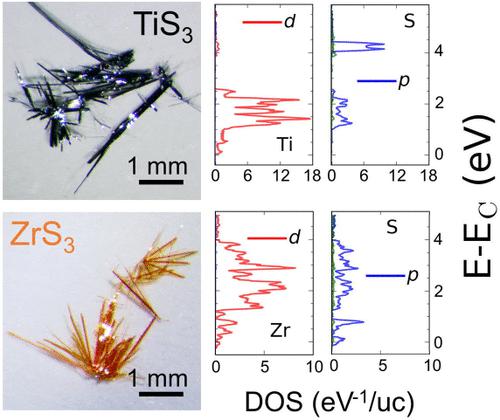当前位置:
X-MOL 学术
›
J. Phys. Chem. C
›
论文详情
Our official English website, www.x-mol.net, welcomes your
feedback! (Note: you will need to create a separate account there.)
Strong Metal–Sulfur Hybridization in the Conduction Band of the Quasi-One-Dimensional Transition-Metal Trichalcogenides: TiS3 and ZrS3
The Journal of Physical Chemistry C ( IF 3.3 ) Pub Date : 2022-10-10 , DOI: 10.1021/acs.jpcc.2c05589 Simeon J. Gilbert 1 , Hemian Yi 2 , Tula Paudel 1, 3 , Alexey Lipatov 4 , Andrew J. Yost 1 , Alexander Sinitskii 4, 5 , Evgeny Y. Tsymbal 1 , Jose Avila 2 , Maria C. Asensio 6 , Peter A. Dowben 1
The Journal of Physical Chemistry C ( IF 3.3 ) Pub Date : 2022-10-10 , DOI: 10.1021/acs.jpcc.2c05589 Simeon J. Gilbert 1 , Hemian Yi 2 , Tula Paudel 1, 3 , Alexey Lipatov 4 , Andrew J. Yost 1 , Alexander Sinitskii 4, 5 , Evgeny Y. Tsymbal 1 , Jose Avila 2 , Maria C. Asensio 6 , Peter A. Dowben 1
Affiliation

|
The elemental contributions to the conduction bands of the transition-metal trichalcogenides TiS3 and ZrS3 were examined using X-ray absorption spectroscopy, at the Ti and S 2p edges and the Zr 3p edges. A comparative study of these two compounds shows that the bottom of the conduction band, for both TiS3 and ZrS3, is comprised mainly of hybridized transition metal–sulfur orbitals, either Ti 3d and S 3p orbitals or Zr 4d and S 3p orbitals. Density functional theory and experiment both indicate that the bottom of the conduction band, in the case of TiS3, has the Ti 3d weight. Although weak, experiment indicates that the S-weighted contribution to the conduction band minimum for ZrS3 is greater than in the case of TiS3. For ZrS3, theory, however, indicates that the conduction band is dominated by hybridization of the Zr 4d and S 3p orbitals, including in the vicinity of the bottom of the conduction band.
中文翻译:

准一维过渡金属三硫属化物的导带中的强金属-硫杂化:TiS3 和 ZrS3
使用 X 射线吸收光谱法在 Ti 和 S 2p 边缘以及 Zr 3p 边缘检查了元素对过渡金属三硫属化物 TiS 3和 ZrS 3导带的贡献。对这两种化合物的比较研究表明,TiS 3和 ZrS 3的导带底部主要由杂化的过渡金属-硫轨道组成,即 Ti 3d 和 S 3p 轨道或 Zr 4d 和 S 3p 轨道。密度泛函理论和实验都表明,在 TiS 3的情况下,导带的底部具有 Ti 3d 权重。虽然很弱,但实验表明 S 加权对 ZrS 3的导带最小值的贡献大于TiS 3的情况。然而,对于 ZrS 3,理论表明导带主要由 Zr 4d 和 S 3p 轨道的杂化支配,包括在导带底部附近。
更新日期:2022-10-10
中文翻译:

准一维过渡金属三硫属化物的导带中的强金属-硫杂化:TiS3 和 ZrS3
使用 X 射线吸收光谱法在 Ti 和 S 2p 边缘以及 Zr 3p 边缘检查了元素对过渡金属三硫属化物 TiS 3和 ZrS 3导带的贡献。对这两种化合物的比较研究表明,TiS 3和 ZrS 3的导带底部主要由杂化的过渡金属-硫轨道组成,即 Ti 3d 和 S 3p 轨道或 Zr 4d 和 S 3p 轨道。密度泛函理论和实验都表明,在 TiS 3的情况下,导带的底部具有 Ti 3d 权重。虽然很弱,但实验表明 S 加权对 ZrS 3的导带最小值的贡献大于TiS 3的情况。然而,对于 ZrS 3,理论表明导带主要由 Zr 4d 和 S 3p 轨道的杂化支配,包括在导带底部附近。


















































 京公网安备 11010802027423号
京公网安备 11010802027423号